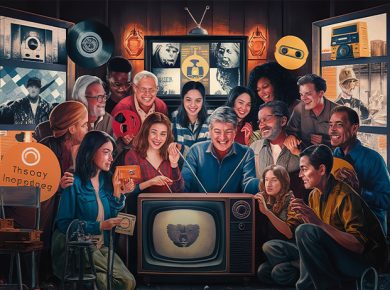Table of Contents
From Audience to Tribe: The Power of Micro-Communities
Hello, Growth Buzzz readers! Today, we’re talking about a shift in digital marketing that’s changing the game: micro-communities. Unlike broad audiences, micro-communities are engaged, loyal groups that connect with your brand on a deeper level, forming what we can call brand tribes. When brands foster these smaller, dedicated groups, they create powerful networks of supporters who are more than just customers—they’re fans, advocates, and even co-creators of brand identity.
In this article, we’ll explore:
- Why micro-communities are so valuable for brands.
- How to build and nurture these engaged brand tribes.
- Stats and case studies demonstrating the impact of micro-communities.
Why Micro-Communities Matter

In the crowded digital space, reaching a massive audience is no longer the most effective approach. Instead, brands are turning to micro-communities to create a more intimate and engaged following. These small groups allow brands to focus on quality interactions rather than sheer quantity, leading to increased loyalty, higher engagement rates, and ultimately, stronger customer relationships.
Stat to Consider:
- 66% of consumers feel more connected to brands that engage with them on a personal level, according to a study by Sprout Social in 2022. Micro-communities provide the perfect platform for brands to make these meaningful connections.

What Makes Micro-Communities So Effective?
Higher Engagement Levels
Micro-communities tend to have much higher engagement rates than large, general audiences. Members of these groups feel like they’re part of something exclusive, which motivates them to actively participate and share their thoughts, feedback, and experiences.
Authentic Brand Advocacy
People in micro-communities are more likely to become brand advocates because they feel personally invested in the community. They’re not just customers; they’re fans who support the brand and want to see it succeed.
Co-Creation Opportunities
Micro-communities offer a unique chance for brands to collaborate directly with their most loyal followers. By gathering feedback, inviting members to participate in product development, or hosting live Q&A sessions, brands can strengthen these connections and even improve their offerings.
Stat to Consider:
- 76% of customers are more likely to support brands that create dedicated communities, as reported by HubSpot. Building a micro-community can increase brand loyalty and foster a sense of belonging.
Examples of Brands Winning with Micro-Communities

Case Study: LEGO Ideas
LEGO has been an innovator in creating engaged micro-communities, especially with its LEGO Ideas platform. This platform allows fans to submit their own designs and vote on others’ creations, with winning designs sometimes becoming official LEGO sets. This strategy has created a dedicated fan base that’s deeply engaged with the brand and even plays a role in its product development.
Impact:
- The LEGO Ideas platform has led to several fan-created sets hitting the shelves, and the brand’s community engagement has skyrocketed. By focusing on co-creation, LEGO transformed its customers into a loyal tribe of brand advocates.
Case Study: Nike Running Club
Nike’s Running Club is a classic example of building a micro-community around shared interests. The club’s members are united by a common goal—to improve their running performance—which has allowed Nike to create an active, engaged tribe that also promotes the brand organically.
Impact:
- The Running Club not only encourages brand loyalty but also serves as an effective way for Nike to gather valuable feedback. It has become a powerful community where users feel connected, motivated, and supported by both the brand and fellow members.
How to Build Your Brand Tribe

Find a Common Purpose
Micro-communities thrive when they’re built around a shared purpose or passion. Think about what your customers care deeply about, and make that the focal point of your community. Whether it’s sustainability, creativity, fitness, or professional development, finding a unifying cause is key.
Action Step:
Identify what values, hobbies, or passions resonate most with your target audience. Create a mission statement for your community that captures this common purpose.
Create Exclusive Content
People want to feel like they’re part of something special. Offering exclusive content, early access to products, or insider information can make members feel valued and motivate them to stay engaged.
Action Step:
Develop a content strategy that includes exclusive updates, behind-the-scenes content, or sneak peeks. Use tools like private Facebook Groups, Discord channels, or invite-only Zoom sessions to keep things intimate.
Engage Directly with Members
Direct engagement is one of the most important aspects of building a micro-community. Regularly interact with members by responding to comments, hosting Q&A sessions, or even conducting polls to gather their opinions.
Stat to Consider:
- According to Social Media Today, 87% of consumers say that brands need to put more effort into meaningful interactions. Micro-communities give brands the perfect space to cultivate these genuine connections.
Encourage User-Generated Content
User-generated content (UGC) is an excellent way to increase engagement within your community. When members contribute their own content, they feel more connected and involved in the brand’s journey.
Action Step:
Create a hashtag campaign or invite community members to share their experiences with your brand. This also has the added benefit of generating authentic content that can attract new members to the tribe.
Building a micro-community isn’t just about creating a fan base; it’s about nurturing a tribe of loyal followers who believe in your brand and feel personally invested in its success. By fostering authentic connections, encouraging active participation, and building around a shared purpose, you can create a community that’s engaged, dedicated, and ready to advocate for your brand.
At Growth Buzzz, we’re all about helping you connect with your audience in meaningful ways. Are you part of a brand tribe that you love? Tell us about it in the comments below, and don’t forget to subscribe for more tips on building engaged brand communities!










